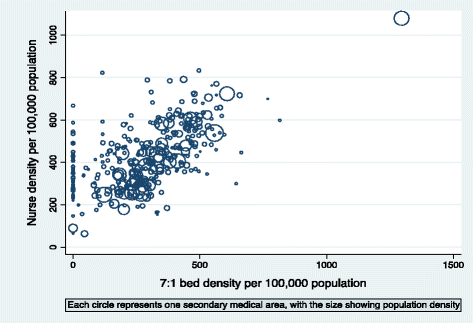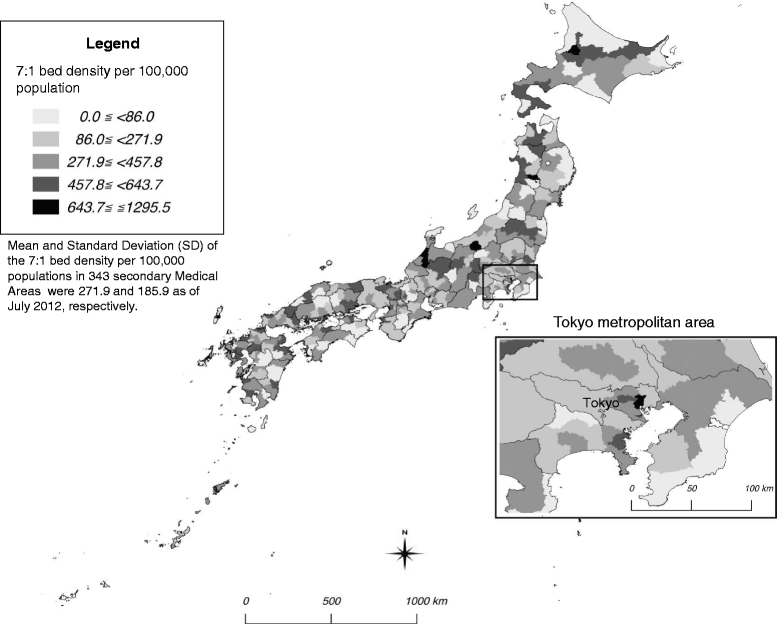The association between higher nurse staffing standards in the fee schedules and the geographic distribution of hospital nurses: A cross-sectional study using nationwide administrative data
- PMID: 28546786
- PMCID: PMC5442664
- DOI: 10.1186/s12912-017-0219-1
The association between higher nurse staffing standards in the fee schedules and the geographic distribution of hospital nurses: A cross-sectional study using nationwide administrative data
Abstract
Background: In Japan, the revision of the fee schedules in 2006 introduced a new category of general care ward for more advanced care, with a higher staffing standard, a patient-to-nurse ratio of 7:1. Previous studies have suggested that these changes worsened inequalities in the geographic distribution of nurses, but there have been few quantitative studies evaluating this effect. This study aimed to investigate the association between the distribution of 7:1 beds and the geographic distribution of hospital nursing staffs.
Methods: We conducted a secondary data analysis of hospital reimbursement reports in 2012 in Japan. The study units were secondary medical areas (SMAs) in Japan, which are roughly comparable to hospital service areas in the United States. The outcome variable was the nurse density per 100,000 population in each SMA. The 7:1 bed density per 100,000 population was the main independent variable. To investigate the association between the nurse density and 7:1 bed density, adjusting for other variables, we applied a multiple linear regression model, with nurse density as an outcome variable, and the bed densities by functional category of inpatient ward as independent variables, adding other variables related to socio-economic status and nurse workforce. To investigate whether 7:1 bed density made the largest contribution to the nurse density, compared to other bed densities, we estimated the standardized regression coefficients.
Results: There were 344 SMAs in the study period, of which 343 were used because of data availability. There were approximately 553,600 full time equivalent nurses working in inpatient wards in hospitals. The mean (standard deviation) of the full time equivalent nurse density was 426.4 (147.5) and for 7:1 bed density, the figures were 271.9 (185.9). The 7:1 bed density ranged from 0.0 to 1,295.5. After adjusting for the possible confounders, there were more hospital nurses in the areas with higher densities of 7:1 beds (standardized regression coefficient 0.62, 95% confidence interval 0.56-0.68).
Conclusion: We found that the 7:1 nurse staffing standard made the largest contribution to the geographic distribution of hospital nurses, adjusted for socio-economic status and nurse workforce-related factors.
Keywords: Geographic distribution of nurses; Health resources; Health services geographic accessibility; Nurse staffing; Nurse workforce; Patient-to-nurse ratio.
Figures


Similar articles
-
Hospital nurse staffing and patient outcomes in Chile: a multilevel cross-sectional study.Lancet Glob Health. 2021 Aug;9(8):e1145-e1153. doi: 10.1016/S2214-109X(21)00209-6. Epub 2021 Jul 2. Lancet Glob Health. 2021. PMID: 34224669
-
[The distribution of hospital nurses and associated factors].Nihon Koshu Eisei Zasshi. 2016;63(7):367-75. doi: 10.11236/jph.63.7_367. Nihon Koshu Eisei Zasshi. 2016. PMID: 27535811 Japanese.
-
Registered nurse, healthcare support worker, medical staffing levels and mortality in English hospital trusts: a cross-sectional study.BMJ Open. 2016 Feb 9;6(2):e008751. doi: 10.1136/bmjopen-2015-008751. BMJ Open. 2016. PMID: 26861934 Free PMC article.
-
Hospital nurse-staffing models and patient- and staff-related outcomes.Cochrane Database Syst Rev. 2019 Apr 23;4(4):CD007019. doi: 10.1002/14651858.CD007019.pub3. Cochrane Database Syst Rev. 2019. PMID: 31012954 Free PMC article.
-
Is nurse staffing associated with critical deterioration events on acute and critical care pediatric wards? A literature review.Eur J Pediatr. 2023 Apr;182(4):1755-1770. doi: 10.1007/s00431-022-04803-2. Epub 2023 Feb 10. Eur J Pediatr. 2023. PMID: 36763191 Review.
Cited by
-
Contributing factors of birth asphyxia in Thailand: a case-control study.BMC Pregnancy Childbirth. 2023 Aug 15;23(1):584. doi: 10.1186/s12884-023-05885-y. BMC Pregnancy Childbirth. 2023. PMID: 37582743 Free PMC article.
-
Degrees of Shortage and Uncovered Ratios for Long-Term Care in Taiwan's Regions: Evidence from Dynamic DEA.Int J Environ Res Public Health. 2021 Jan 12;18(2):605. doi: 10.3390/ijerph18020605. Int J Environ Res Public Health. 2021. PMID: 33445714 Free PMC article.
-
Perceptions of nurse managers and staff nurses regarding Technological Competency as Caring in Nursing theory in general hospitals in Japan.Belitung Nurs J. 2021 Dec 6;7(6):467-475. doi: 10.33546/bnj.1767. eCollection 2021. Belitung Nurs J. 2021. PMID: 37497288 Free PMC article.
-
Influence of Nursing Time and Staffing on Medication Errors: A Cross-Sectional Analysis of Administrative Data.Nurs Rep. 2025 Jan 5;15(1):12. doi: 10.3390/nursrep15010012. Nurs Rep. 2025. PMID: 39852634 Free PMC article.
-
Employment status of older nursing staff aged 55 years and older in care facilities: A nationwide cross-sectional study in Japan.Glob Health Med. 2024 Aug 31;6(4):225-235. doi: 10.35772/ghm.2024.01026. Glob Health Med. 2024. PMID: 39219583 Free PMC article.
References
-
- Aiken LH, Sloane DM, Bruyneel L, Van den Heede K, Griffiths P, Busse R, Diomidous M, Kinnunen J, Kozka M, Lesaffre E, McHugh MD, Moreno-Casbas MT, Rafferty AM, Schwendimann R, Scott PA, Tishelman C, van Achterberg T, Sermeus W, RN4CAST consortium. Nurse staffing and education and hospital mortality in nine European countries: a retrospective observational study. Lancet. 2014; doi:10.1016/S0140-6736(13)62631-8 [doi]. - PMC - PubMed
-
- Kane RL, Shamliyan TA, Mueller C, Duval S, Wilt TJ. The association of registered nurse staffing levels and patient outcomes: systematic review and meta-analysis. Med Care. 2007; doi:10.1097/MLR.0b013e3181468ca3 [doi]. - PubMed
-
- Griffiths P, Ball J, Drennan J, Dall’Ora C, Jones J, Maruotti A, Pope C, Recio Saucedo A, Simon M. Nurse staffing and patient outcomes: Strengths and limitations of the evidence to inform policy and practice. A review and discussion paper based on evidence reviewed for the National Institute for Health and Care Excellence Safe Staffing guideline development. Int J Nurs Stud. 2016; doi:S0020-7489(16)30004-9 [pii]. - PubMed
-
- Shekelle PG. Nurse-patient ratios as a patient safety strategy: a systematic review. Ann Intern Med. 2013; doi:10.7326/0003-4819-158-5-201303051-00007 [doi]. - PubMed
-
- Stalpers D, de Brouwer BJ, Kaljouw MJ, Schuurmans MJ. Associations between characteristics of the nurse work environment and five nurse-sensitive patient outcomes in hospitals: a systematic review of literature. Int J Nurs Stud. 2015; doi:10.1016/j.ijnurstu.2015.01.005 [doi]. - PubMed
LinkOut - more resources
Full Text Sources
Other Literature Sources

